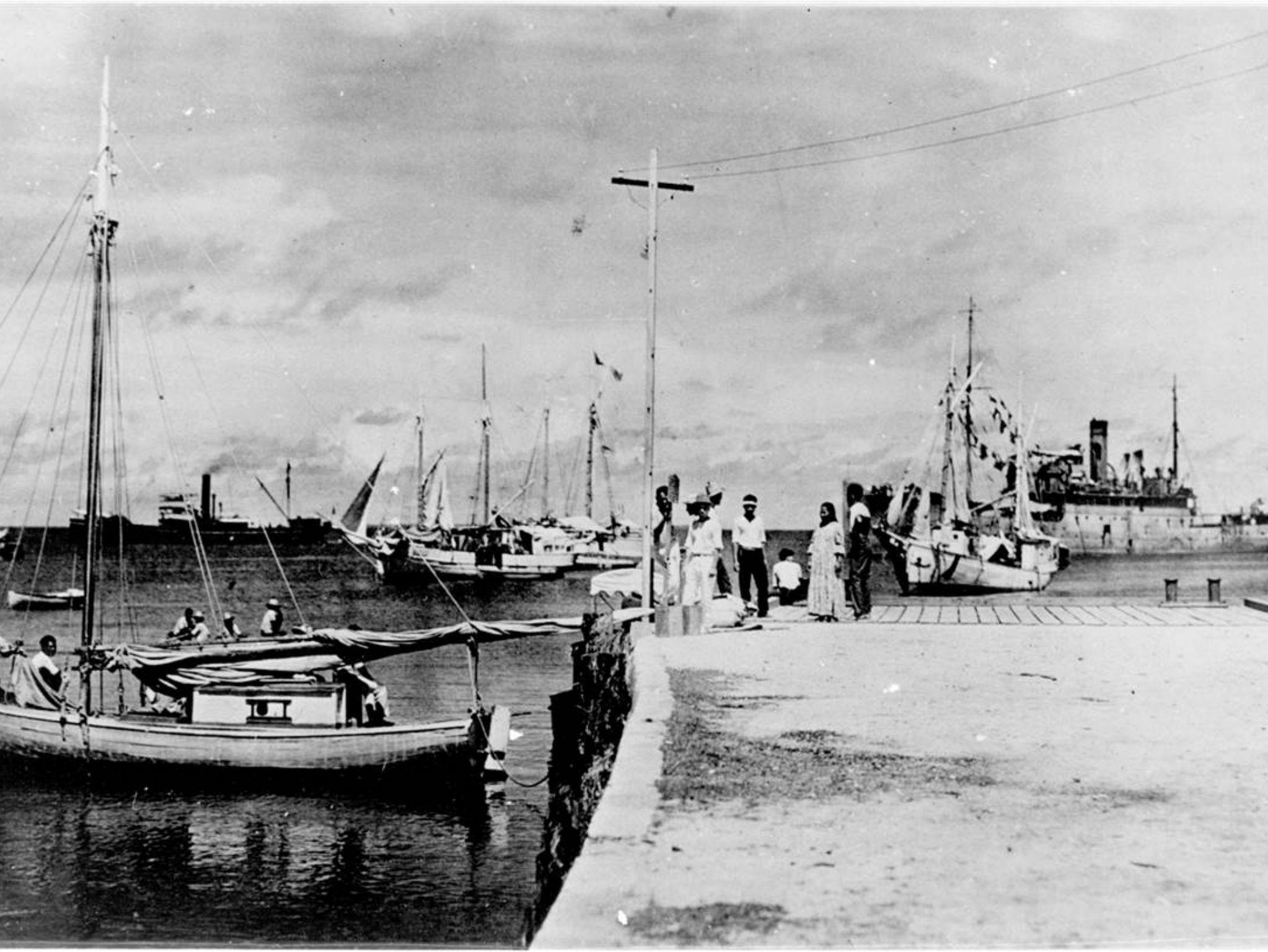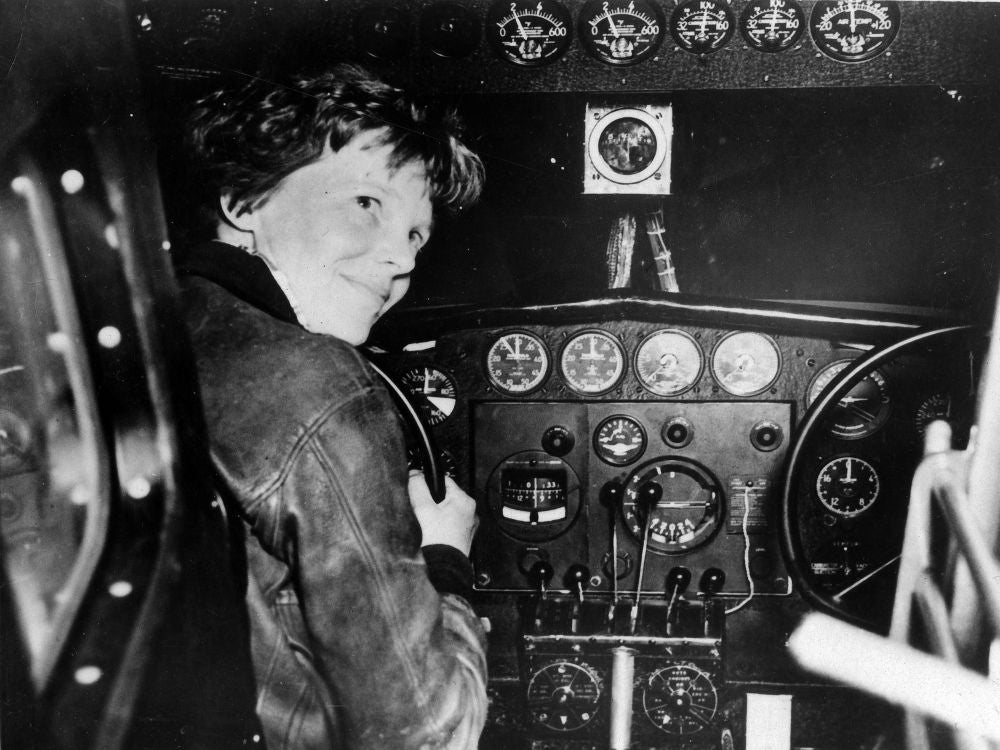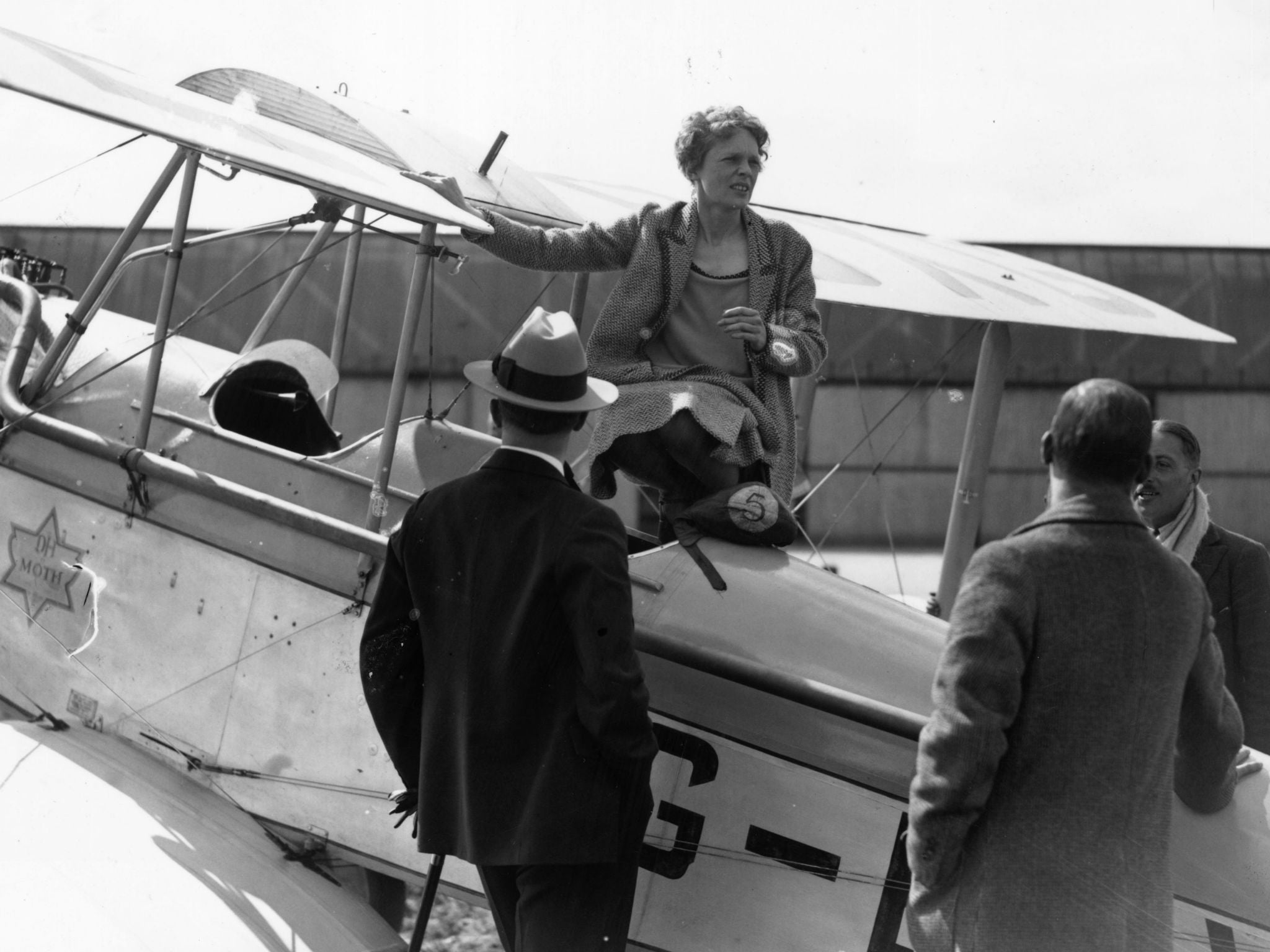Amelia Earhart: Why she should be remembered for much more than her mysterious disappearance
With the riddle of her last flight now seemingly solved, attention may focus on how the pioneer pilot defied 'the inheritance of age-old customs that women are bred to timidity'

Your support helps us to tell the story
From reproductive rights to climate change to Big Tech, The Independent is on the ground when the story is developing. Whether it's investigating the financials of Elon Musk's pro-Trump PAC or producing our latest documentary, 'The A Word', which shines a light on the American women fighting for reproductive rights, we know how important it is to parse out the facts from the messaging.
At such a critical moment in US history, we need reporters on the ground. Your donation allows us to keep sending journalists to speak to both sides of the story.
The Independent is trusted by Americans across the entire political spectrum. And unlike many other quality news outlets, we choose not to lock Americans out of our reporting and analysis with paywalls. We believe quality journalism should be available to everyone, paid for by those who can afford it.
Your support makes all the difference.In 1960 an old US coastguard told a curious reporter a tale he had heard some 14 years before on the Pacific island of Nikumaroro
Not long after the island was first settled in 1938, said Floyd Kilts, a local man was walking by the shore: “There in the brush about 5ft feet from the shoreline he saw a skeleton. What attracted him to it were the shoes. Women’s shoes, American kind…”
Was this, the old coastguard wondered, the key to what really happened to Amelia Earhart , the aviation pioneer who had disappeared in 1937 while attempting to become the first woman to fly around the world?
Even in 1960, the mystery was assuming mythical proportions.
Some were suggesting that Earhart had actually been on a secret spying mission for US President Franklin Roosevelt; that she had survived and returned to the US to live under a false identity.

In time, there would be speculation that Earhart had been captured by the Japanese, sometimes with the embellishment that she had been forced to become the voice of “Tokyo Rose”, taunting US servicemen with propaganda broadcasts during the Second World War.
The official US government position remained that Earhart and her navigator Fred Noonan had crashed into the Pacific Ocean and died at sea while trying to reach Howland Island.
Now Kilts was suggesting the pair had died as castaways on what had then been an uninhabited, waterless Pacific atoll some 350 miles from their intended destination.
“Beside the body,” he said, “Was a cognac bottle with fresh water in it for drinking. Further down the beach ... A man’s skull.”
But not too many listened to the old coastguard man.
In the telling and retelling between 1938 and 1960, his tale had acquired impossible embellishments, the addition of “Natives as superstitious as the devil [who] threw the gunnysack full of bones overboard, scared of the spirits.”
It was only much later that Earhart investigators realised there had indeed been weather-beaten bones found on Nikumaroro. But even then the document trail showed that the British colonial authorities had dismissed the possibility of them belonging to the aviator.
They were from a long-dead “elderly male of Polynesian race”, snapped the maverick Gilbert Islands District medical officer Dr Lindsay Isaac.
“It may be definitely stated that the skeleton is that of a MALE,” added Dr D W Hoodless, principal of the Central Medical School, Fiji, with considerably more authority, in 1941.

Now, though, a startling new analysis of the bleached bones has been conducted – albeit using historical photographs because some time after 1941 the skeletal fragments really were discarded, and not by stereotypically superstitious “natives”.
Writing in the journal Forensic Anthropology, University of Tennessee professor Richard Jantz challenges Dr Hoodless’ certainty that the bones were from a man.
In the 1940s, says Prof Jantz, forensic osteology - the study of bones - was still in its early stages, and therefore, for all his eminence, Dr Hoodless might have got things wrong.
Prof Jantz’s own analysis - using everything from skeletal measurements to computer modelling to the work of a “historical seamstress” who could estimate "the inseam length and waist circumference of Earhart's trousers" - has come to the opposite conclusion.
“From a forensic perspective,” writes Prof Jantz, “The most parsimonious scenario is that the bones are those of Amelia Earhart … Until definitive evidence is presented that the remains are not those of Amelia Earhart, the most convincing argument is that they are hers.”
Old Kilts, it seems, was right after all: Amelia Earhart really did die as a castaway on Nikumaroro.
And if the mystery really has been solved, it may allow the focus to shift once and for all on to something else: not how Amelia Earhart died, but how she lived.
“Yes”, wrote Dorothy Cochrane, curator of the Aeronautics Department at the Smithsonian National Air and Space Museum last year. “We do want to know what happened to her. Why? Because Amelia Earhart dared to be different.”
Long before she became the first woman to fly across the Atlantic, long before she tried to become the first woman to fly around the world, Earhart was defying what she later called “the inheritance of age-old customs, which produced the corollary that women are bred to timidity”.
She did it with courage. “Please know that I am aware of the hazards,” she wrote to her husband George Putnam, in her last letter before her final voyage. “[But] Women must try to do things as men have tried. When they fail, their failure must be a challenge to others.”
She also did it with style. After the New York Times hailed her 1932 Atlantic crossing with the headline, “Mrs Putnam flies Atlantic in record time,” she wrote to Arthur Hays Sulzberger, the newspaper’s publisher, politely asking to be known professionally, not by reference to her husband, but as Amelia Earhart.
When the newspaper complied, she gave them a photo for the boardroom, and she signed it “Amelia Earhart (Putnam) *
“* See New York Times.”
She may have enjoyed being named by the Fashion Designers of America as one of the 10 best dressed women in the US in 1934, but from the start Earhart delighted in defying the expectations placed on young women.
As a child, she climbed trees, hunted rats with a .22 rifle and kept a scrapbook of newspaper cuttings about accomplished women.
She took a car mechanics course, and when aged 23, she was first taken up in a plane, as a passenger on a 10-minute air show joy ride in 1920: "As soon as I left the ground, I knew I myself had to fly."
She paid for her flying lessons with jobs that included being a truck driver.
Shortly after completing her first solo flight in 1921, Earhart bought a second-hand Kinner Airster biplane, painted it bright yellow and nicknamed it “the Canary”.
The next year she flew the Canary up to 14,000 feet, the world altitude record at the time for female pilots.
Then in 1923 she got her pilot’s licence from the Federation Aeronautique, the world governing body for aeronautics. She was the 16th woman in the world to have such a pilot’s licence.
It was during her spell as a social worker helping poor immigrants in a “settlement house” in Boston in 1928 that Earhart was asked if she wanted to join an expedition that would make her the first woman to fly across the Atlantic.
She leapt at the chance – even though, on the 20 hour, 40 minute flight from Newfoundland to Wales with Wilmer Stultz and Lou Gordon she was not herself able to take the controls of the Fokker FVII aeroplane.
The flight, however, gave her a first taste of international fame, and bought her into contact with the publicist George P. Putnam, (GPP), who became her manager and - eventually - her husband. He proposed six times before she said yes.
And on the morning of 7 February 1931, their wedding day, she sent him a letter.
“Dear GPP,” she told him, “There are some things which should be writ before we are married.
“You must know again my reluctance to marry, my feeling that I shatter thereby chances in work which means most to me.
“Please let us not interfere with the others’ work or play … I cannot guarantee to endure at all times the confinements of even an attractive cage.”
Fifteen months after her wedding, On 21 May 1932, she became the first woman to complete a solo, non-stop flight across the Atlantic.
Four hours into her 2,026-mile flight, Earhart revealed, “I saw flames shooting from the exhaust pipe.”
“I became uneasy,” she admitted. “It would have taken four hours to return, however, so I thought it would be safer to go ahead.”
Then she realised the fuel tank of her Lockheed Vega 5B monoplane was leaking.
She flew on, with the exhaust manifold of her engine burned out and only tomato juice to keep her own energy levels up.
Fourteen hours and 56 minutes after leaving Harbour Grace, Newfoundland, she said, “After scaring most of the cows in the neighbourhood, I pulled up in a farmer’s back yard.”
“Have you flown far?” a farmhand asked. “From America,” she replied.

Earhart returned home to a ticker tape parade in New York. Congress awarded her the first Distinguished Flying Cross to be given to a woman.
Back in Britain, praising her achievement while perhaps also revealing the prejudice she had to overcome, the Manchester Guardian reported: “She has succeeded in proving that the flight is not beyond the knowledge and the capacity for sustained endurance which a woman can acquire.”
Earhart herself felt she had proved that men and women were equal in “jobs requiring intelligence, coordination, speed, coolness, and willpower”.
By that time, she had already become the founder president of the Ninety-Nines, a group of 99 women out of 285 licensed female pilots in the US who came together to provide mutual support and encouragement.
The group still exists today, as an international organisation representing women flyers from 44 countries.
In 1935 Earhart became the first person to fly solo across the Pacific from Honolulu to Oakland, California. The time, for sustenance on the 2,408-mile flight, she took a thermos of hot chocolate.
The next year an Amelia Earhart Fund for Aeronautical Research was created, which would raise the $80,000 needed to buy the Lockheed Electra 10E two-motor all-metal monoplane that was going to take her and Noonan around the world.
The money was raised with the help of Purdue University, Indiana, and writing about her “world circling project” Earhart allowed herself a “considerable digression” – one that revealed her as a pioneer of more than just aviation.
Purdue, she wrote, was “a forward-looking institution” and not just because it was one of the few universities in the world to have its own landing field.
“It is co-educational,” wrote Earhart. “Of its 6,000 students approximately 1,000 are women. The problems and opportunities of these girls were quite as much my concern as aviation matters.
“Perhaps I have something of a chip on my shoulder when it comes to modern feminine education … I have known girls who should be tinkering with mechanical things instead of making dresses.”
Earhart allowed herself to dream of young women learning in a “catch-as-can machine-shop, where girls may tinker to their heart's content with motors, lathes, jigsaws … Peering up into the innards of engines, and likely as not get oil in their hair.”
“One of my favourite phobias,” she wrote, “Is that girls, especially those whose tastes aren’t routine, often don’t get a fair break. The situation is not new. It has come down through the generations, an inheritance of age-old customs, which produced the corollary that women are bred to timidity.”
Those words were published posthumously, in Last Flight, a collection of diary entries and notes gathered together by her husband, who, as she hoped he would, had never tried to keep her in an “attractive cage”.
Noonan and Earhart had just 7,000 miles left of their 29,000-mile circumnavigation when they took off from Lae, New Guinea, on 2 July 1937.

They were heading for Howland Island, 2,556 miles away, where after a flight of at least 18 hours, the US Coast Guard cutter Itasca would be waiting with fuel.
Two other ships were positioned along the expected flight route, with orders to turn on every one of their lights, to act as markers.
“Howland is such a small spot in the Pacific that every aid to locating it must be available,” Earhart had insisted.
Hoping to arrive at around dawn, they took off with the forecast predicting fair weather. Instead they encountered cloud, which made it hard for Noonan to use his preferred technique of navigating by the stars.
At 7:42am the crew of the Itasca picked up a radio message from Earhart: “We must be on you, but we cannot see you. Fuel is running low. Been unable to reach you by radio. We are flying at 1,000 feet.”
The ship tried to reply. Earhart and Noonan seemed not to hear.
At 8.43am, Earhart radioed the ship: “We are running north and south.”
Then she and Noonan were heard no more.
As she had told her husband, Amelia Earhart knew the risks, but she was damned if she was going to give in to what some might have sought to characterise as feminine “timidity”.
She had effectively made a record of her attitude before her first transatlantic expedition in 1928, when she left what she called “popping off” letters, in case she never returned.
“Dearest Dad,” read the “popping off” letter to her father. “Hooray for the last grand adventure! I wish I had won, but it was worthwhile anyway.”
Nine years later, the grand adventure finally claimed her, but by then it could never destroy her legacy.
Her bleached bones may have ended up on Nikumaroro, but Amelia Earhart survives in the memory of her deeds, and in words which even now have the power to inspire anyone, of whatever gender.
“The most difficult thing,” she once said. “Is the decision to act. The rest is merely tenacity. The fears are paper tigers. You can do anything you decide to do.”
Join our commenting forum
Join thought-provoking conversations, follow other Independent readers and see their replies
Comments